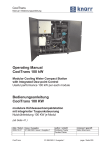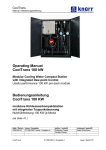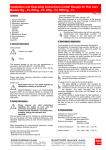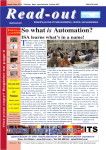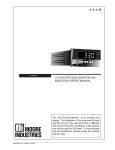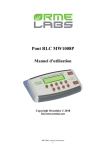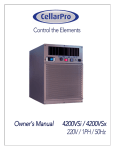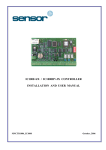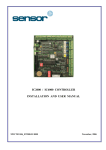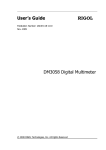Download Installation and Operating Instructions Bourdon Tube Pressure
Transcript
Installation and Operating Instructions Bourdon Tube Pressure Gauge RSCh/RSChOe with integrated Pressure Transmitter DMU page 1 of 10 Contents 1. 2. 3. 4. 5. 6. 7. 8. 9. 10. Important Information in Advance Safety Information Description, Application Technical Data Installation Storing and Transport Maintenance and Repair Accessories Declaration of Conformity Electrical Disturbances p. 1 p. 1 p. 3 p. 7 p. 8 p. 9 p. 9 p. 9 p. 9 p. 10 1. Important Information in Advance Please read these operating instructions carefully before using the bourdon tube pressure gauge RSCh or RSChOe with integrated pressure transmitter DMU. You have purchased an instrument that has been manufactured with a high quality standard in our company which is certified according to DIN ISO 9001. Should there however arise a reason for any complaint, please return the instrument to our factory with a precise description of the malfunction. The bourdon tube pressure gauge RSCh or RSChOe with integrated pressure transmitter DMU is manufactured in accordance with the valid standards. The following operating instructions have been composed carefully. However, it is not possible to take all the variants and possible applications into consideration in these operating instructions. Please contact us as manufacturer or the distributor when planning to use this equipment for a special application or when there are any questions regarding storing, installation, operation or arising difficulties. For special versions, please note the specification according to the delivery note. Please also support us in improving these operating instructions. We will be happy to receive your comments. Applications that are not explicitly listed as intended, are contrary to normal use. ARMATURENBAU GmbH and MANOTHERM Beierfeld GmbH do not assume liability for damage that arises from misuse of the device resp. from not regarding the information contained in these operating instructions. Do not manipulate this device. Otherwise you will lose your warranty! 2. Safety Information Please observe the valid instructions regarding the safety at work and the prevention of accidents, as well as the country-specific installation standards when installing, putting into operation and operating. The installation, putting into operation and the control of the operation are only to be executed by qualified personnel, meaning persons who are acquained with installation, mounting, putting into operation and operation of the product as well as the country-specific standards and possess the corresponding knowledge resp. qualification. When disregarding the corresponding instructions, injuries and/or damage to property may occur. In order to ensure the accuracy of the measuring and the durability of the instrument and to avoid damage, the indicated limit values stated in the technical data have to be observed. Before installing and putting into operation, please make sure that you have chosen an instrument that is regarding to the load limits, as well as to the compatibility of the material and measuring material adequate for your purposes. In case of visible damage (e.g. leaking liquids) or malfunctions the instrument has to be decommissioned immediately resp. an installation and putting into operation must not take place. Please only use intact, faultless bourdon tube pressure gauges with integrated pressure transmitter! B40 07/12 Installation and Operating Instructions Bourdon Tube Pressure Gauge RSCh/RSChOe with integrated Pressure Transmitter DMU All parts have to be protected against incorrect handling when installing the instrument. To avoid damage, please only touch the designated areas, as described below. page 2 of 10 3.1.2 Construction of Bourdon Tube Pressure Gauge It must be ensured that the cable diameters match the nominal widths of the sealing inlets. Screwed joints must be tightened firmly. Compliance with the certified protection standards can only be ensured this way. The centrally arranged fixing screw in the terminal box has to be hand-tightened. For equipment with a magnetic contact it must be noted that the CE-marking in accordance with EMC guidelines will only apply when a switching frequency of 5 switching cycles per minute is not exceeded. When indicated, suitable switching amplifiers or multifunctional relays have to be used (e.g. for instruments with inductive limit switch assembly). The valid operating instructions have to be respected. Pressure Gauge in line with Safety Requirements According to EN 837-1, S3 Full blow-out pressure relief back Case with solid front Window made of multilayer safety glass Bayonet ring The measuring unit must be depressurized before the pressure gauge is removed. When required, the pressure in the measuring line must be relieved. Residual media in dismantled pressure gauges may present a hazard to personnel, environment and facilities. For this reason suitable safety precautions must be introduced. 3. Description, Application 3.2 Principles of Measurement The information provided in these operating instructions relating to the selection, application, measuring arrangement, installation and operation applies to pressure gauges with an elastic sensing element. The pressure gauges described in these operating instructions contain components which are subject to elastic deformation when exposed to pressure. This movement is transferred to a movement with a pointer. Because of their ruggedness and simple usage these pressure gauges are commonly used throughout the industry. The elastic elements themselves are generally made from copper alloyed steel. 3.1 Elastic Elements, Construction Bourdon Tube Pressure Gauge 3.1.1 Elastic Elements C-Type Bourdon Tube Helical Bourdon Tube Pressure Gauges with Bourdon Tube Bourdon tubes are oval tubes bent into a circular arc. The pressure which is to be measured acts upon the interior of the tube so that the tube’s oval cross section becomes approximately circular. The edge stress produced through this deforming effect causes the arc of the bourdon tube to open. The end of the bourdon tube which is not affixed performs a motion, this motion being a measure for pressure. For pressure ranges up to 40 bar bourdon tubes bent into a circular arc angle of 270 degrees are commonly used, for higher pressure ranges helical bourdon tubes having several turns are employed. Bourdon tubes have a relatively low restoring force. B40 07/12 Installation and Operating Instructions Bourdon Tube Pressure Gauge RSCh/RSChOe with integrated Pressure Transmitter DMU This must be taken into account when using additional accessories like indicating pointers, limit switches or potentiometric transmitters since these will affect the readings obtained. Pressure gauges with a bourdon tube can normally only be protected in a limited way against overloading by supporting the elastic element at a specific pressure limit. Bourdon tube pressure gauges with integrated pressure transmitter are commonly used in class 1.0 for measurements in the range between 1.0 and 1600 bar. The influence of temperature changes on the indication depends chiefly on the temperature coefficient that is specific for the elastic modulus of the bourdon tube. Depending on the material used, the accuracy error caused by temperatures differing from the reference temperature will amount to between 0.3 % and 0.4 % per 10 K. 3.3 Pressure Ranges The operating pressure should be in the mid. third of the pressure range specified for the gauge. The maximum pressure load should not exceed 75% of full scale value at static loads, or 65 % of full scale value for pulsating loads. Refer to EN 873-2. 3.4 Accuracy Limits The accuracy limits for pressure gauges with bourdon tube have been defined in EN 873-1. 3.5 Conditions of Usage When selecting pressure gauges the selection criteria and installation recommendations in accordance with EN 873-2 as well as the instructions provided here, especially in para. 3.6, 3.7 and 3.9, must be observed. The use of pressure gauges which do not meet the requirements encountered in practice can cause great consequential damage. 3.6 Pressure Media Properties, March of Pressure The actual elastic element must not be exposed to sudden rapid pressure changes or pressure spikes. In the case of pressure spikes the pressure limits specified for the gauge must not be exceeded. If required, overload protection means (refer to para. 4) must be provided upstream. Pressure changes in excess of 10 % of the full scale value per second will impair the readings. Moreover, this will severely impair the service life of the gauges. In such cases attenuators must be provided. Through throttling components (restrictor screw or adjustable snubber) the cross section at the inlet can be much reduced in order to delay the transmission of the pressure change to the gauge. Fitting of a throttling line (a line with a reduced cross section) ahead of the gauge is also possible. In both cases the increased risk of accumulating contamination is a disadvantage. Attenuating components at the movement will only delay the movement of the pointer. Filling the case with fluids will attenuate the movement of the elastic element and will help to reduce wear on moving parts. page 3 of 10 Temperature If the temperature of the pressure medium at the point where it is measured deviates from the operating temperature specified for the pressure gauge (refer to para. 3.11 as well as EN 873-1, -2, -3) then a sufficiently long measuring line, a siphon or a chemical seal with a capillary line must be mounted to the pressure gauge. The influence on the reading owing to temperatures deviating from +20 °C must be observed. Highly Viscous, Crystallising and Solids Containing Media For running measurements on highly viscous, crystallising or solid-containing pressure media, the use of bourdon tube pressure gauges with attached chemical seal is recommended. Corrosive Pressure Media If corrosive pressure media can be kept away by separating means from the elastic element, then standard gauges may be used. Otherwise the selection of a suitable material is mandatory, whereby the user must provide to the manufacturer all information on the materials which under the given conditions are compatible with the pressure medium, refer to EN 873-2, 4.3. Because of the limited choice of materials for the elastic elements, chemical seals made of pressure media resistant materials may need to be mounted to the bourdon tube pressure gauge. Safety There is an increased risk with gases and fluids under high pressure, for example. In case of developing leaks or bursting of pressurized components, persons in front of the viewing window of the instrument must not be injured by the pressure medium escaping to the front. Safety pressure gauges with blow-out device on the back, will offer the required degree of protection (refer to the fig. in the middle of page 2). When using hazardous pressure media , for example - oxygen - acetylene - combustible substances - toxic substances as well as refrigerating units, compressors etc. the applicable regulations must be observed. 3.7 Ambient Conditions Vibrations If an exposure of the pressure gauge to vibrations can not be avoided by suitable installation, gauges equipped with damping devices for the movement or gauges with a fluid filling must be used. Ambient Temperature The accuracy limit given on the dial applies at a reference temperature of +20 °C. Deviating temperature will have an influence on the reading. The extent of the influence depends on the principle of measurement (refer to para. 3.1). At outdoor services, the prevailing ambient conditions must be taken into account to prevent the formation of ice on the pressure gauge at temperatures below 0 °C, for example. B40 07/12 Installation and Operating Instructions Bourdon Tube Pressure Gauge RSCh/RSChOe with integrated Pressure Transmitter DMU For liquid-filled instruments it has to be considered that the viscosity of the fluid will increase as the temperature drops causing delayed reading. The ambient temperature needs also to be taken into account regarding the maximum allowed operating temperature specified for the pressure gauge. Corrosive Atmosphere For services at corrosive atmospheres suitable casings and components made of corrosion resistant materials must be provided. Also special surface finishing may help to protect the outside of the pressure gauges. 3.8 Accessories Shut-off Fittings for Pressure Gauges It is recommendable to fit shut-off devices between the measuring point and the pressure gauge. This will allow an exchange of the pressure gauge and checks on the zero setting while the system remains operative. Depending on the application either cocks or valves are used. Cocks have three positions: - Vent: The supply line is shut off and the gauge is connected to the atmosphere. The zero setting can be checked. - Operation: The supply line is open, the gauge is pressurized. - Blow-out: The supply line is open, the pressure medium is allowed to escape into the atmosphere. The gauge is not working. page 4 of 10 available in a variety of different types. In case of in-line seals or flange type diaphragm seals the pressure gauge must be mounted to the instrument at the suitable fitting position by the manufacturer. The connection between the pressure gauge and the chemical seal must not be disconnected. Potential sources of inaccuracy by installing a chemical seal ahead of the pressure gauge need to be considered. Overpressure Protection Facilities If the pressure range of the gauge has to be chosen below the maximum operating pressure for operational reasons, overpressure protection devices ahead of the pressure gauge may be used to protect it against damages. In the event of pressure spikes the overrange protector will shutdown immediately, but only gradually at slow rising pressure. The closing pressure which needs to be set up therefore depends on the specific pressure change with time. However, highly viscous and much contaminating pressure media may impair proper operation of the overrange protector or render these ineffective. 3.9 Set-up Options General Well proven measuring arrangements and proposals for components are detailed in VDE/VDI 3512 Sheet 3. The following table shows an overview of possible set-up options In the case of valves (according to DIN 16270 and DIN 16271, for example) a venting screw is usually provided between valve seat and pressure gauge. Venting into the atmosphere must be arranged in a way that any persons present close by are not endangered by the escaping pressure medium. Potential hazards to the environment must be avoided. In certain applications (steam boilers, for example) the shut-off fitting must have a test port so that the pressure gauge can be checked without having to remove it from the system. Holding Devices for the Pressure Gauge A suitable holding device for the pressure gauge should be provided, if the line the gauge is connected to is not strong enough to support it without introducing vibrations. Siphons Use sufficiently long lines ahead of the pressure gauge or siphons to protect the shut-off fittings and the gauge against being heated up by hot pressure media (e.g. hot steam). Chemical Seals In the case of aggressive, hot, highly viscous or crystallising pressure media, chemical seals can be used as separating means ahead of bourdon tube pressure gauges in order to prevent the ingress of such pressure media into the elastic element. A neutral fluid serves the purpose of transmitting the pressure to the elastic element. The fluid must be selected depending on the measuring range, temperature, viscosity and other influences. Special emphasis must be placed upon the compatibility of the fluid with the pressure medium. Chemical seals are Pressure Measuring Ports The pressure measuring port should be located at a point where the flow is not impaired in any way and where constant conditions can be ensured for the measurements. It is recommended to provide a sufficiently large orifice at the point of the pressure measurement and to provide some means for the pressure measuring port off. B40 07/12 Installation and Operating Instructions Bourdon Tube Pressure Gauge RSCh/RSChOe with integrated Pressure Transmitter DMU Measuring line The connection between pressure measuring port and pressure gauges is the measuring line. The inside diameter of this measuring line should be sufficiently wide in order to avoid the risk of blockages. The measuring line should have a steady slope (recommended is a slope of 1:15). With gases as the pressure medium a drain should be provided at the lowest point and with high-viscosity fluids a vent should be provided at the highest point. In the case of gases containing solids or fluids, separators should be provided which may be demounted from the running system for emptying. The measuring line should be designed and fitted in a way that it will be capable of sustaining the occurring loads caused by expansion, vibration or thermal effects. Shut-off fittings Shut-off fittings at the pressure gauge serve the purpose of checking the zero setting or exchanging the pressure gauge while the system remains operational (refer to para. 3.8). Pressure Gauge The pressure gauge needs to be mounted so that it will not be subjected to vibrations and shocks and so that the dial can be read easily. When reading the dial, parallax errors should be avoided. It must be ensured that potential blowout devices of the pressure gauge are not blocked (refer to EN 837-1, 9.7). The pressure gauge must be arranged in such a manner that the temperature of the gauge will not drop below or exceed the permissible operating temperature range (refer also to para. 3.4.1 and 7). In doing so, the influences of convection and thermal radiation should be taken into account. Whenever the elastic element of a pressure gauge will be filled with water or a water mixture the instrument must be protected against frost. Usually the pressure gauge will be fitted with the dial arranged vertically. In all other cases the position indicating symbol according to EN 837 (formerly DIN 16257) applies. A difference in height between the port at which the pressure is measured and the pressure gauge will cause a shift at the beginning of the reading if the pressure medium in the measuring line is of a different density compared to the ambient air. This shift ∆ p at the beginning of the reading results from the difference in density (ρM − ρL) and the -5 difference in height ∆ h: 10 · ( ρM − ρL ) g · ∆ h ∆ ρM ρ L ∆h g = Shift at the beginning of the reading [bar] = Density of the pressure medium [kg/m³] = Density of the air (1,205 at 20 °C) [kg/m³] = Difference in height [m] = Acceleration due to gravity [m/s²] (mean acceleration due to gravity = 9,81 m/s²) The reading is reduced by ∆p if the pressure gauge is located above the pressure measurement port and increased by ∆ p if below the pressure measurement port. page 5 of 10 3.10 Installation of the Bourdon Tube Pressure Gauge Please refer to para. 3.9 for advice on measurement arrangements. During installation or removal never apply any forces to the case of the pressure gauges, instead apply the wrench to the wrench flats provided. It must be ensured that the matching process connection has been selected (nominal width, suitable sealing face, if required). In order to position the pressure gauge so that it may be read perfectly the use of a clamping sleeve or a union nut is recommended. In the case of flange joints the pressure gauge is placed on the mating flange and the flanges are joined using suitable bolts. It must be ensured that the bolts are tightened firmly. The joints must be leaktight. For this reason it is mandatory that suitable gaskets made of a material resistant to the pressure medium will be used in the connections. For sealing connections with a parallel thread, for example, flat gaskets in accordance with EN 837-1 or profile seals must be fitted, or on the other hand the corresponding sealing lens has to be provided in case of a high pressure connection. Tapered threads (for example NPT threads) are sealed off with additional sealants like PTFE tape, for example (refer to EN 837-2) Parallel thread Tapered thread Wrench flats Sealing surface Seal in the thread For pressure gauges with a pressure relief vent of Ø 13 mm at the top of the case it is recommended for pressure ranges ≤ 6 bar to cut off the nipple at the filling plug so that the gauge can be vented in order to compensate the internal pressure. If the pressure gauge is located below the pressure measurement port, the measuring line should be purged well before starting operation so as to remove any foreign objects which might be present in the line. During pressure tests on pipes or vessels, the pressure gauge must not be exposed to excessively high pressures on the as indicated by the pressure limit indicating mark dial, resp. the limits for a static pressure specified for the pressure gauge must not be exceeded (refer to para. 3.11). In the case of instruments with attached chemical seals the connection between gauge and chemical seal and possibly also the connection between chemical seal and capillary line must not be disconnected. B40 07/12 Installation and Operating Instructions Bourdon Tube Pressure Gauge RSCh/RSChOe with integrated Pressure Transmitter DMU Before disconnecting and removing the pressure gauge unit from the measuring point it must be depressurized first. If required the pressure in the measuring line must be relieved. Residues of the pressure medium in pressure gauges which have been removed may present a hazard to personnel, facilities and the environment. For this reason suitable safety precautions must be introduced (Electric limit switch contact assemblies: refer to para. 3.13). page 6 of 10 Cleaning Temperature Also when purging the measuring line the permissible operating temperature for the pressure gauge (refer to above) must not be exceeded. If required the gauge will have to be shut-off or removed. In the case of pressure gauges with attached chemical seals the maximum cleaning temperature tR must not be exceeded. 3.12 Integrated Pressure Transmitter DMU 3.11 Operation of the Bourdon Tube Pressure Gauge Shut-off devices may only be opened slowly in order to avoid sudden pressure spikes during start-up. Specified Usage on the The usable range for static loads is indicated by dial of many pressure gauges (refer to EN 837-1, EN 8373). Bourdon tube pressure gauges having a nominal size of 100 may be subjected to the respective full scale pressure if the load is static. If the pressure load is of a pulsating nature, pressure peaks amounting to only 0.9 of the full scale pressure are permissible. Bourdon tube pressure gauges can be overloaded up to 1.3 of their full scale value. Zero Check In order to check the zero setting of the pressure gauge during operation of the system, the required shut-off device has to be closed (refer to para. 3.9) and the pressure in the gauge has to be relieved. The pointer must come to rest within the zero range indicated by . If the pointer comes to rest outside of this range then a persisting deformation of the elastic element must be assumed so that the gauge will have to be checked in order to avoid accidents owing to incorrect measurements. In such a case the pressure gauge should, for this reason, be replaced and returned to the manufacturer for checking and repair if required. Pressure Range Check If the readings supplied by the pressure gauge need to be checked while the remainder of the system is operating, the pressure gauge has to be separated from the process via the required shut-off device with test port (refer to para. 3.9) and a test pressure has to be applied to the gauge. The error limits according to EN 837-1 resp. EN 837-3 apply. Operating Temperature The permissible operating temperature for the pressure gauge must not be exceeded (refer to para. 4.1, 4.2). Special versions which are labelled accordingly (tA / tR) can be suitable for higher temperatures. Note: These are only information on the temperature resistance of the materials respectively the soldered joints or welded seams. The information on indication errors due to deviations from the reference temperature have to be regarded. The pressure transmitter which is mounted inside the bourdon tube pressure gauge is a temperaturecompensated pressure sensor with an integrated measuring amplifier that converts the measured pressure into a calibrated output signal qualified for transmission and control purposes. The measuring point of the pressure transmitter is separated from the measuring system of the bourdon tube with the result that both measurements are independent. A defective measuring mechanism of the pressure gauge does not have influence on the measurement of the pressure transmitter, for example. The version of the pressure transmitter is stated on the nameplate: 1 2 3 4 Basic model 5 Output signal Pressure range 6 Pin assignment Serial number 7 Zero Adjustment Power supply (≤0/60 bar) 3.13 Electric Limit Switch Contact Assembly Instruments with electric limit switch contact assemblies are tagged with a nameplate which indicates how the electric connection has to be carried out. The load limits must be observed. Exceedance of the load limits can lead to damages. The national and international safety standards (e.g. VDE 0100) must be followed for installation, putting into operation and for operation of the instruments. Detailed information on the operation of the Bourdon tube pressure gauges with electric limit switch contact assembly can be found in the separate operating instructions. B40 07/12 Installation and Operating Instructions Bourdon Tube Pressure Gauge RSCh/RSChOe with integrated Pressure Transmitter DMU page 7 of 10 4. Technical Data 4.1 Bourdon Tube Pressure Gauge Accuracy (EN 837-1) Class 1.0 Case With bayonet ring, stainless steel Protection Class according to EN 60529/IEC 529 IP 54 (RSCh) IP 55 (RSChOe) Blow-out device Blow-out back; when pressure is built up inside of the case, the entire case back separates, allowing full relief. Case Ventilation Typ RSCh... Typ RSChOe via screw with ventilation bore Case Filling Model RSChOe: spezial oil Nominal Size 100 mm (4") Wetted Parts Connection: Bourdon tube: Stainless steel Stainless steel Argon arc welding, ≤40 bar C-form ≥60 bar Helical 1600 bar NiFe-alloy, Helical Case Configuration Connection: screwed Position of the connection: bottom Mounting device : without, optional back flange for surface mounting (Rh) / front flange for panel mounting (Fr) see data sheet 1600 Safety Category according to EN 837-1 S3, Safety case with break-proof solid front behind the dial and blow-out back, proved: pressure ranges up to 1000 bar, bottom connection: RSCh and RSChOe marking S 4.2 Pressure Transmitter Piezoresistive sensor (up to including 60 bar) Output signal auxiliary supply Resistance [] 4...20 mA (2-wire) 10...40 VDC (UB-10V)/0.02A 0...20 mA (3-wire) 8...28 VDC (UB- 8V)/0.02A 0...10 V (3-wire) 13...28 VDC min. 10k Thin film sensor (100 bar and above) Output signal auxiliary supply Resistance [] 4...20 mA (2-wire) 9...30 VDC (UB- 9V)/0.02A 0...20 mA (3-wire) 9...30 VDC (UB- 9V)/0.02A 0...10 V (3-wire) 14...30 VDC min. 10k Measuring Accuracy ±0,5 % v. E, including linearity and hysteresis Temperature Ranges for Pressure Gauges with DMU Storage temperature: -40...+70 °C (for RSCh) -20...+70 °C (for RSChOe) Rated Temperature: -40...+60 °C (for RSCh) -20...+60 °C (for RSChOe) Medium Temperature: max. +80°C Temperature Influence in the Rated Temperature Range Zero Point <0.3 % of full scale value / 10 K Span <0.2 % of full scale value / 10 K Reference Temperature +20 °C (+68 °F ) Long-term Stability of Zero point and Span Better than 0.25 % p. a. Terminal Box Pressure Ranges (EN 837-1) 0/1 (-1/0) to 0/1600 bar Process Connection ½" BSP Window Laminated safety glass Movement Stainless steel Dial Aluminium, black figures, white background B40 07/12 Installation and Operating Instructions Bourdon Tube Pressure Gauge RSCh/RSChOe with integrated Pressure Transmitter DMU page 8 of 10 Electrical Connection The terminals are numbered according to the wiring diagrams. A protective conductor terminal is provided. The terminal is equipped with a screwed cable gland M20x1.5 with a pull relief. To assure the electromagnetic compatibility (EMC) please use a shield cable (e. g. LP/LiMYCY). The shield has to be connected to the case resp. to the ground terminal of the terminal box 2-wire-connection (4...20 mA) 5. Installation Mounting Remove the packaging carefully. Dispose the packaging in accordance with ecological principles resp. in accordance with the local waste treatment and disposal regulations! Please ensure that concerning pressure range, version, protection class and material (risk of corrosion) the suitable pressure gauge has been chosen for the individual case before mounting, putting into operation and operation of the instrument! For technical data, please see the data sheets in the download area of http://armaturenbau.com resp. http://manotherm.com. 3-wire-connection (0...20 mA, 0...10 V) Please avoid any contamination and damage to the process connection and especially to the sealing surface! Do not insert any objects to the process connection! Protection Class according to EN 60529/IEC 529 IP 65 (Terminal box) The stated protection class is only reached with a firmly mounted cable box and the corresponding seal. Zero Adjustment Measuring Spans up to including 0/60 bar Our pressure transducers are factory-adjusted. Therefore changes in these settings must not be made. However, should a process-related zero adjustment be necessary, please do following: Open the central screw of the terminal box and remove the cover Now you can adjust the zero point on the exposed trimmer with a screwdriver (ZERO, see connection drawing above) An adjustment of the full scale value must never be made at all (SPAN, trimmer on the top right next to ZERO, see layout)! Measuring Ranges from including 0/100 bar A potential zero point adjustment can only be made exfactory by computer using an appropriate software (programmable ASIC electronics). Connections between chemical seals and pressure transducers must not be loosened! Any existent seals must not be damaged! The screw on the chemical seal must by no means be loosened. For installation at the measuring point only use the fitting torque wrench for process connections with wrench flat. The wrench is only to be inserted at the designated wrench flat. The right starting torque depends on the material and on the shape of the used seal resp. sealing material. Use shape flat sealing ring according to DIN 16258 for pressure connections according to DIN EN 837. Use pre-installed shape E elastomer profile packing for pressure connections according to DIN 3852! Fasten tapered pressure connections. Use sealing material! For diaphragm seal connections, e.g. for food industry, use a seal which is suitable for the specific chemical seal! Proper seals for the specific connection must be used under all circumstances. Even the minutest leak may, depending on the conditions of usage, result in unforeseeable injuries and damage to property! The position of installation is arbitrary, however the instrument has to be mounted vibration-free and may not be exposed to strong variations in temperature. Please consider an additional error in measurement for temperatures deviating from the reference temperature of +20 °C! Avoid direct pressure blasts on the sensor membrane placed inside! Use attenuators (restrictor screws without bore, etc.) in case of doubt, if possible! B40 07/12 Installation and Operating Instructions Bourdon Tube Pressure Gauge RSCh/RSChOe with integrated Pressure Transmitter DMU page 9 of 10 6. Storage and Transport Bourdon tube pressure gauges with integrated pressure transmitter comprise sensitive sensors. When keeping the instruments in stock before mounting they should be left in the original packaging and should be maintained in stock well protected against damage by external influences. If the pressure measuring instrument was taken out of its packaging and inspected briefly (e.g. for testing) it should be carefully placed back in the same packaging before returning it to stock. Particularly the protection cap of the process connection should not be removed before installation. In general the temperature limits for storing that are indicated in the data sheets have to be observed. The temperature should not come below or exceed the mentioned temperature limits (see EN 837-1 and EN 837-2). 7. Maintenance and Repair Our bourdon tube pressure gauges with built-in pressure transmitter do not require maintenance. Please send us any instrument with malfunctions which can not be troubleshooted without intervention to the instrument including a precise description of the error. Any arising repairs may only be executed by the manufacturer. We recommend regular inspections to ensure the accuracy of the measurement. For this procedure the instrument has to be disconnected from the process and has to be checked with an appropriate test device. 8. Accessories Sealings: Overrange Protection Piston Valve Stainless steel, data sheet 11500 Adjustment ranges: Order number: 0.4 - 2.5 bar 2 - 6 bar 5 - 25 bar 20 - 60 bar 50 - 250 bar 240 - 400 bar 100 004 30 01 100 004 30 02 100 004 30 03 100 004 30 04 100 004 30 05 100 004 30 06 Snubber with laterally fixable spindle, stainless steel G ½ female x ½" BSP Order number: 100 003 30 01 9. CE Declaration of Conformity The CE-marking of the instruments indicates conformity with the applicable EU directives for placing products on the market within the European Community. Following directives apply: 89/336/EEC (EMC) and 97/23/EC (PED) The corresponding declaration of conformity is enclosed or respectively available upon request. Order number: CU flat gasket ¼" BSP, M12x1.5 ½" BSP, M20x1.5 100 011 80 01 100 011 80 02 CU profile seal ¼" BSP, M12x1.5 ½" BSP, M20x1.5 100 011 80 05 100 011 80 06 Cooling Elements Model KEl, KElv and KElvR For medium temperatures up to +150 °C / +250°C, see data sheet 7002 (only for models which are not supplied with a built-in temperature decoupler, model code TE) B40 07/12 Installation and Operating Instructions Bourdon Tube Pressure Gauge RSCh/RSChOe with integrated Pressure Transmitter DMU page 10 of 10 10. Electrical Disturbances Description Possible cause Remedy No output signal Missing operating voltage apply operating voltage cable broken check the cable and repair it wiring fault check the wiring and correct it missing input pressure check pressure connection, apply pressure usage conditions not permissible return to works with a description of the malfunction and the usage conditions orifice is clogged check measuring point, clean it carefully and if necessary return with a description of the malfunction pressure transmitter is defective return with a description of the malfunction incorrect measurement range replace pressure transmitter pressure transmitter is defective return with description of malfunction incorrect measurement range replace pressure transmitter for current signal: load is too high for voltage signal: load is too low reduce load or increase operating voltage change load operating voltage is too low increase operating voltage pressure transmitter is defective return with description of the malfunction zero point has changed due to not permissible operating conditions return with description of the malfunction not permissible operating voltage apply allowed operating voltage pressure transmitter is defective return with description of the malfunction measurement span has changed due to the operating condictions or improper calibration at the potentiometers return with description of the malfunction pressure transmitter is defective return with description of the malfunction Output signal constant Output signal too high Output signal too low Incorrect zero signal Non-linear output signal B40 07/12










